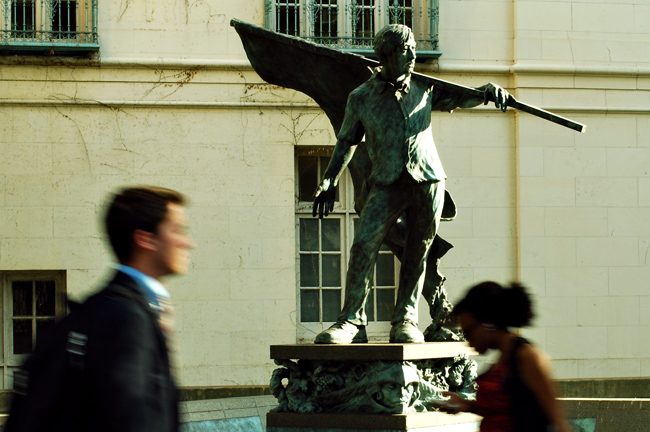Editor’s note: This story is the fifth in a series exploring race, racism and diversity on the UT campus.
A simple stroll around the 40 Acres tells you a lot about UT’s complicated history with racism on campus.
Permanent fixtures of the University’s ties to race and racism are scattered throughout campus. From the representations of Confederate figures in the South Mall to the more recently unveiled statues of Martin Luther King Jr. and Barbara Jordan, each encompass a part of the complex mosaic that is UT’s racial past and present.
Edmund T. Gordon, chair and associate professor of African and African Diaspora Studies, gives tours of the UT campus to explain its ties to racism. Gordon said the campus’ structure is evidence of its racial past, seen most obviously in the Tower’s facing south toward the South Mall.
“There is a huge South Mall because we want to respect our southern heritage and the confederacy,” Gordon said.
Gordon said the South Mall’s Confederate statues and the Littlefield Fountain are symbolic of the University’s history of racist values.
“This is about a glorification of the Confederacy and of a particular moment in history when the South and North are brought together under a democratic president and under a notion of white supremacy,” Gordon said.
Gordon said while he is in favor of keeping the current statues, there needs to be an explanation of their significance to the campus.
“There needs to be some way in which the University recognizes that there’s a debate around these things,” he said. “The thing to remember is that the past of the University is built into its structure and the past of the University is a racist past.”
David Gracy, School of Information professor emeritus, said he agreed with Gordon’s view that the controversial statues should not be removed, but sees the statues as symbolic of something other than racism. Gracy’s great-great-uncle, George Littlefield, was a law professor at UT whose personal funding helped keep UT at its current location and who was commemorated with the construction of the Littlefield Fountain.
Gracy said the Confederate statues in the South Mall were placed next to the Littlefield Fountain as a memorial to celebrate the reunification of the North and South to fight in World War I. He said the figures were intended to serve as sources of inspiration, just like the statues commemorating the civil rights movement.
“They were built in part as a memorial to those who gave their lives in service to their country,” Gracy said. “You include subsequent examples of men whose leadership is particularly admirable. The Martin Luther King statue is an excellent example of that.”
Gracy said examining the statues from a historical and sociological standpoint sheds light on how our society views race.
“Having them there allows us to look at history to see what they originally meant, and as time has gone forward to see what succeeding generations have tried to make them mean,” he said.
Journalism professor Gene Burd has been teaching classes exploring race in the media since he came to UT 40 years ago. Burd said the issue of race on campus was obvious when he first arrived.
“UT-Austin was rather late in becoming a part of the modern civil rights movement,” he said. “That affected enrollment here, it affected courses and it hurt UT’s reputation.”
Other notable fixtures around campus include Robert Lee Moore Hall, named for a former professor known for excluding black students from his classes, and the Perry–Castañeda Library, which was named after notable black and Latino professors at UT.
Burd said while many people propose the removal of the Confederate statues, he does not. Rather, he believes statues of figures like Martin Luther King Jr. and Barbara Jordan, the first black female elected to the Texas House of Representatives and a former UT adjunct professor, complement them in giving a full view of history.
“If you’re not willing to accept that your past is still a part of you, you’re lost,” he said. “You can’t just erase it. In order to understand the present and what’s going on now, you have to know what all has happened.”
Amber Chenevert, an advertising graduate student and president of the Black Graduate Student Association, said the history behind the issue of racism is still unfolding even today. Chenevert said she is concerned about a lack of balance on campus.
“The UT campus should reflect all the races, ethnicities and genders that encompass it,” she said. “There needs to be a balance of representation that is an actual reflection of campus and the people there.”
Chenevert said all changes that have taken place, such as the erection of statues of Barbara Jordan and Cesar Chavez, are a product of the struggle of many students.
“These changes are the result of the struggle at UT from the beginning,” she said. “As a larger variety of people have been allowed over time to attend UT, they’ve wanted to be represented on campus fairly and fully.”
Chenevert said this struggle is still taking place.
“We’re still fighting to this day for equality and balanced representation,” Chenevert said.
Printed on Tuesday, May 1, 2012 as:UT fixtures show complex history





















